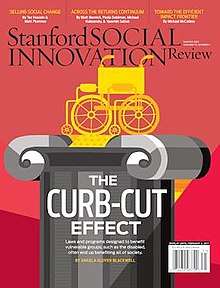Stanford Social Innovation Review
Stanford Social Innovation Review is a quarterly magazine-cum-website about social innovation published by the Stanford Center on Philanthropy and Civil Society[3] at Stanford University. SSIR covers a wide range of topics,[4] including nonprofit management, philanthropy, corporate citizenship, and social change. It also publishes a wide range of related videos, webinars, and podcasts.
 | |
| Editor |
|
|---|---|
| Categories | Social innovation magazine |
| Frequency | Quarterly |
| Publisher | Stanford Center on Philanthropy and Civil Society, Stanford University |
| First issue | Spring 2003[2] |
| Country | United States |
| Based in | Palo Alto, California |
| Language | English |
| Website | ssir |
| ISSN | 1542-7099 |
The publication was founded in 2003 by the Center for Social Innovation (CSI), a Hewlett Foundation grantee[5] at the Stanford Graduate School of Business. Today, SSIR distributes its print version to over 400 retail locations throughout the U.S. and Canada.
SSIR frequently publishes in-depth series[6] in partnership with organizations such as the Bridgespan Group, Mission Investors Exchange,[7] BBB's Give.org,[8] Third Sector Capital Partners, and The Communications Network.[9]
Mission
SSIR aims to advance, educate, and inspire the field of social innovation by seeking out, cultivating, and disseminating the best in research- and practice-based knowledge.[10]
History and impact
SSIR was launched in 2003 by the Center for Social Innovation (CSI) at the Stanford Graduate School of Business.[11] Beginning in 2010, SSIR has been published at the Stanford Center on Philanthropy and Civil Society (PACS).[12]
Nonprofit terms such as the nonprofit starvation cycle[13] and collective impact [14][15][16] were first given prominence by SSIR in 2009 and 2011, respectively. The latter term was introduced by John Kania and Mark Kramar in their article Collective Impact, and became the number two philanthropy buzzword for 2011, according to The Chronicle of Philanthropy. It has also been recognized by the White House Council for Community Solutions.[17]
Current activity
Since 2006, SSIR has hosted the annual Nonprofit Management Institute[18] conference, a 2-day conference for senior-level nonprofit executives.[19] In 2015, SSIR hosted its first annual Data on Purpose conference,[20][21] which was then combined with the Do Good Data conference in 2017.[22] In 2016, SSIR hosted the inaugural Frontiers of Social Innovation, a forum for global leaders.[23][24] SSIR has also hosted the "SSIR Live!" webinar series since 2009.
Awards
SSIR has won several Maggie Awards for Best Quarterly (2010, 2011, 2012, 2013, 2014)[25] and Best Web Publication (2016), Eddie Awards (2011, 2014),[26] an Ozzie Award for its website (2014), and Min's Best of the Web Award for Redesign (2013).[27]
References
- "SSIR Team". Stanford Social Innovation Review. Retrieved 2017-06-28.
- "Spring 2003". Stanford Social Innovation Review.
- "Stanford Social Innovation Review". pacscenter.stanford.edu. Retrieved 2017-06-28.
- "Get to Know the Stanford Social". Innov8Social. 2011-10-13. Retrieved 2017-06-28.
- "Hewlett Grantee Launches Stanford Social Innovation Review". Hewlett Foundation. Retrieved 2017-06-28.
- "Supplements | Stanford Social Innovation Review". ssir.org. Retrieved 2017-06-28.
- "Announcing Our New Mission Possible Series in SSIR | Mission Investors Exchange". www.missioninvestors.org. Retrieved 2017-06-28.
- "Advancing Collaboration - give.org". www.give.org. Retrieved 2017-06-28.
- "Case Study: The Power of Convening for Social Impact". The Communications Network. Retrieved 2017-06-28.
- "Overview | Stanford Social Innovation Review". ssir.org. Retrieved 2017-07-06.
- "History of the Center for Social Innovation". gsb.stanford.edu. Retrieved 2017-07-06.
- "Interview with Kim Meredith, Executive Director of Stanford PACS & SSIR". Innov8Social. 2013-06-24. Retrieved 2017-07-06.
- "The Nonprofit Starvation Cycle". Retrieved 2017-07-14.
- "The Nonprofit Starvation Cycle (SSIR)". ssir.org. Retrieved 2017-07-06.
- "The Nonprofit Starvation Cycle: Can Penniless Charities Help the Hungry?". Fundraising Letters, Checklists, How Tos and Event Ideas. 2017-02-15. Retrieved 2017-07-06.
- "Ending the Nonprofit Starvation Cycle". Hewlett Foundation. 2014-09-04. Retrieved 2017-07-06.
- "Community Collaborative Whitepaper: A Promising Approach to Addressing America's Biggest Challenges" (PDF). Corporation for National and Community Service.
- "Nonprofit Management Institute". www.ssirinstitute.org. Retrieved 2017-07-06.
- "Reflections from Stanford Nonprofit Management Institute: New Skills for a Complex World". Beth’s Blog. 2012-09-13. Retrieved 2017-07-06.
- "Data on Purpose | Do Good Data 2017". Data on Purpose | Do Good Data 2017. Retrieved 2017-07-06.
- "Data storytellers share narrative tips at Data on Purpose conference". ijnet.org. Retrieved 2017-07-06.
- "Reflections: Data on Purpose / Do Good Data". Digital Impact. 2017-05-11. Retrieved 2017-07-06.
- "Frontiers of Social Innovation". Frontiers of Social Innovation. Retrieved 2017-07-06.
- "Frontiers of Social Innovation". www.globalinnovationexchange.org. Archived from the original on 2017-11-07. Retrieved 2017-07-06.
- "MAGGIE Awards – Western Publishing Association". wpa-online.org. Retrieved 2017-07-06.
- "2011 Folio: Award Winners Announced - Folio". Folio. 2011-11-01. Retrieved 2017-07-06.
- "min's Best of the Web Award Winners Announced - min Online". min Online. 2013-04-15. Retrieved 2017-07-06.